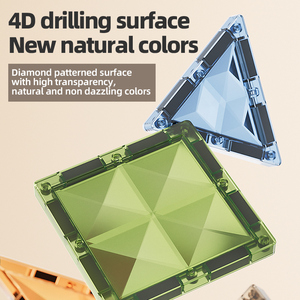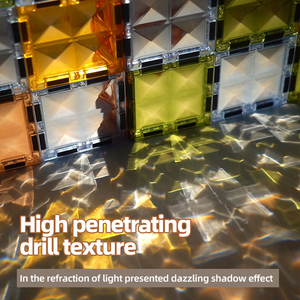
All categories
Featured selections
Trade Assurance
Buyer Central
Help Center
Get the app
Become a supplier

(1796 products available)




















































Building blocks are one of the most famous toys for children. They are available in various types, each having its benefits. Here are some common types of building blocks 48pcs toys:
Plastic Building Blocks
These are classic interlocking bricks like the building blocks 48pcs. They come in different colors and sizes. Kids can use their imagination to create structures. The blocks help develop fine motor skills. They also encourage creativity and spatial awareness. The blocks are easy to connect and disconnect. This makes them ideal for young builders.
Wooden Building Blocks
Wooden building blocks are a traditional favorite. They are durable and non-toxic. The blocks come in different shapes and sizes. This allows kids to explore geometric concepts and balance. Their larger size and smooth surfaces make them perfect for young kids. This is because they are easy to grasp. It is also hard to put them in the mouth. Stacking wooden blocks helps develop hand-eye coordination. It also improves problem-solving skills.
Foam Building Blocks
These are soft and lightweight. This makes them easy for small hands to handle. The blocks are colorful and come in different shapes. They allow kids to build soft and safe structures. Foam blocks provide a sensory experience. This is because they are squishy and have different textures. Stacking the lightweight blocks is good for developing fine motor skills. It also improves spatial awareness.
Magnetic Building Blocks
These are sets of magnetic tiles or rods. They allow for quick and easy assembly. This encourages kids to create intricate designs. The blocks help develop an understanding of basic engineering concepts. They also encourage creativity. The tiles have magnets sewn into the edges. This allows them to attract and connect easily from any angle. They are good for teaching symmetry and geometric shapes.
Biodegradable Building Blocks
These are eco-friendly building blocks. They are made from renewable materials like soy or cornstarch. The blocks offer the same benefits as plastic blocks, but with less environmental impact.
Picking the right set of building blocks is a crucial decision that can affect how kids play and develop. It is important to consider various factors to ensure the selected block set aligns with the child's interests and developmental needs.
Age and Developmental Stage
When choosing building blocks for a 48-piece set, the first thing to consider is the child's age. Larger, softer blocks are better for younger children because they help them not to get hurt and build their motor skills. Older kids, on the other hand, might like smaller, more complicated blocks that let them build more complex things. Also, look at how advanced the child is. If the child can stack blocks well, they might need a set with more pieces or special parts that make building more fun.
Material and Safety
Safety comes first, so choose blocks made of safe materials. Soft blocks made of vinyl or foam are good for small kids because they are gentle and cannot hurt anyone. Harder blocks made of plastic should be big enough for younger kids so that they do not choke. Whichever material is picked, make sure the colors are bright and that it is made of safe stuff that can be easily cleaned. Also, see if the blocks have smooth edges. This prevents kids from getting hurt.
Interactivity and Educational Value
Some block sets come with extras like printed patterns, numbers, or letters that can make learning more fun. These printed parts can help kids learn how to count, read, and solve problems. Also, think about sets that have pieces that fit together in special ways to make building more interesting. These sets might have pieces that slide into each other or parts that make them move.
Durability and Quality
Pick a block set that is made well so it can be played with a lot and lastingly be used for years. Good-quality blocks are made of strong materials that do not break easily. This makes them safe for kids to play with and lets them be used by different kids as they grow.
Value and Versatility
Look for block sets that give a lot of fun for the price. A set with 48 pieces is good because it has enough blocks to let kids build different things without being too big to play with. Also, consider if the blocks can be played with in different ways or if they can be joined with other sets later. This makes the block set a good choice for kids as they grow and their playtime changes.
Non-toxic Materials
To ensure the safety of its products, including the building blocks 48pcs, the company uses non-toxic materials such as ABS or polypropylene. These materials are safe for children to play with and do not pose any health risks.
Smooth Edges
Building blocks with smooth edges and rounded corners prevent cuts and scratches, making them safe for children to handle and assemble. A good example is Lego. They ensure that all their building elements have smooth edges.
Certifications
Certifications from reputable organizations such as ASTM or CE indicate that the toys have been tested for safety and meet industry standards. Toys that bear these marks are safe for kids to use.
Age Recommendations
Building blocks with clearly defined age recommendations ensure that the toys are suitable for the developmental stage of the child. This prevents younger children from accessing toys with small parts that can cause choking hazards.
Choking Hazard Warnings
Warnings about choking hazards on packaging advise against certain toys for young children. This helps to ensure that the toys are kept out of reach of children who may put small parts in their mouths.
Reputable Brands
Building blocks from reputable brands are known for their quality and safety standards. They have a history of producing reliable and durable products that meet customer expectations.
Durability
Durable building blocks that are resistant to breaking or splintering are important for safety reasons. This ensures that the toys can withstand rough play and do not pose a hazard if they break.
Colorful and Engaging Designs
Building blocks with colorful and engaging designs capture the attention of children and encourage imaginative play. This helps to ensure that the toys are used safely and do not become a source of boredom or disinterest.
Clear Instructions
Clear instructions on how to use and assemble building blocks help to ensure that the toys are used correctly and safely. This prevents accidents or injuries that may occur from improper use.
Can building blocks help improve a child's language skills?
Yes, building blocks can improve a child's language skills. As children describe their creations, they negotiate with their peers, and in the process, they engage in dialogues. This assists in the development of vocabulary, pronunciation, and grammatical structure. To foster language development even further, caregivers may join in children's block play and encourage them to tell stories about their creations.
What is the appropriate age range for the 48-piece building block set?
The building blocks in a 48-piece set are usually intended for children over the age of three. They are large enough to prevent choking but still manageable for small hands. The package will indicate the recommended age for the product, which should be followed for the user's safety.
Are building blocks a good toy for travel?
Yes, building blocks are a great toy for travel. They are educational and keep children entertained. Small sets with a carrying case or those designed to stack compactly are great for taking on the go. They allow children to explore new environments while providing them with a sense of stability and familiarity.
How can parents ensure their building block sets are safe?
To ensure building blocks are safe, check for sets that meet safety standards, are age-appropriate, and are made of non-toxic materials. Avoid sets with small parts for younger children and inspect them regularly for wear and tear. Also, supervise young children during play and ensure they use them as intended.